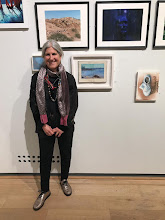 |
| Final version St James' Park, egg tempera on panel, 26x16 cm |
Having had a few sessions working with egg tempera lately, I decided to revisit the panel I began with Ruth Stage back in June 2017. Ruth introduced me to working with egg tempera. Anthony Williams who also works in egg tempera held an NEAC workshop at around the same time, but his was a portrait drawing workshop. The two artists work is very different ways and with any media it's up to the person working with it to find something to say that the media enhances.
The picture above is the new version of what you see below, which was begun in the Mall Galleries learning centre. I worked from a drawing I made at lunch time and only had about 2 1/2 hrs to begin to find my feet with a new media and to find something to say about St James' Park. Not having the information in front of me (referring to a drawing instead of working from direct observation is always difficult for me but John Dobbs reckons you need to just fight through all those uncomfortable feelings to find something worthwhile and authentic to say. All I know is, I I have been moving the panel around the studio and wincing every time I caught sight of it, so I knew the process was going to be prickly but was absolutely necessary!
 |
| Forst version, St James' Park, egg tempera on panel, 26x16 cm |
|
You can see Ruth's work here: https://www.newenglishartclub.co.uk/artists/ruth-stage-neac
and Anthony Williams' work here:https://www.antony-williams.com
Before I began I looked at a few people to find direction, found my original pastel drawing and printed off a black and white version of the photo I took of the scene after I finished my drawing.
What I looked at for inspiration was images by Wolf Kahn and Thomas Lamb:
 |
| Wolf Khan, by Justin Spring, p 143 |
 |
| Thomas Lamb, Browse and Darby catalogue, 2017 |
I worked for most of the day, going in many different directions, sanding, scumbling, glazing, cross hatching and eventually found something to say that felt like me and reminds me of my monotypes. Phew.





























